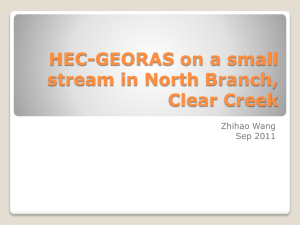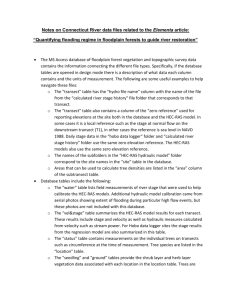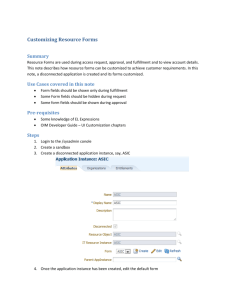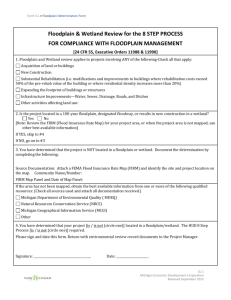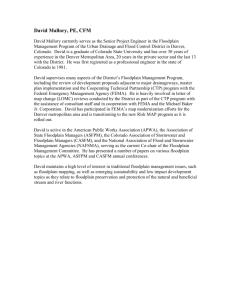Point X="3034981.00" Y="10347339.00" Z="" Station=""
advertisement
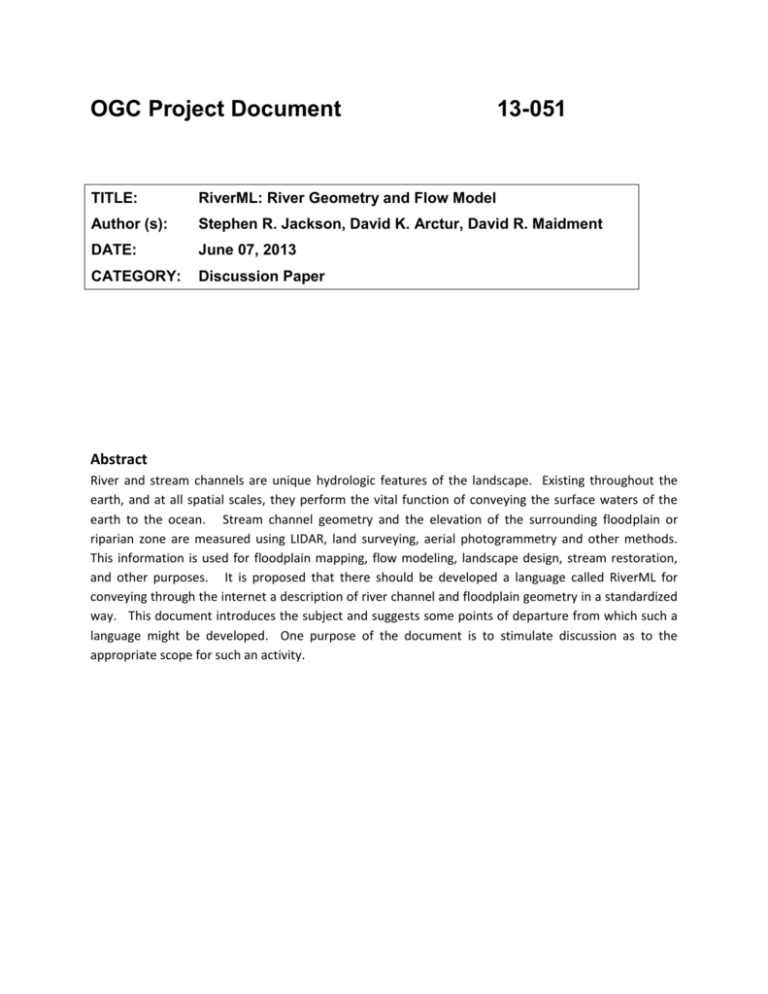
OGC Project Document 13-051 TITLE: RiverML: River Geometry and Flow Model Author (s): Stephen R. Jackson, David K. Arctur, David R. Maidment DATE: June 07, 2013 CATEGORY: Discussion Paper Abstract River and stream channels are unique hydrologic features of the landscape. Existing throughout the earth, and at all spatial scales, they perform the vital function of conveying the surface waters of the earth to the ocean. Stream channel geometry and the elevation of the surrounding floodplain or riparian zone are measured using LIDAR, land surveying, aerial photogrammetry and other methods. This information is used for floodplain mapping, flow modeling, landscape design, stream restoration, and other purposes. It is proposed that there should be developed a language called RiverML for conveying through the internet a description of river channel and floodplain geometry in a standardized way. This document introduces the subject and suggests some points of departure from which such a language might be developed. One purpose of the document is to stimulate discussion as to the appropriate scope for such an activity. Contents Abstract ............................................................................................................................................. i Preface ............................................................................................................................................. iii Submitting organizations .................................................................................................................. iii Document contributor contact points ................................................................................................ iii Revision History ................................................................................................................................ iii Introduction ......................................................................................................................................1 A Flood Mapping Use Case .................................................................................................................3 XML Structure Summary ....................................................................................................................7 GIS to RAS (Prototype for RiverML) ....................................................................................................7 Header ..............................................................................................................................................7 Stream Network ................................................................................................................................7 Cross Sections ....................................................................................................................................8 Additional User-Defined Attributes ....................................................................................................8 Additional Features............................................................................................................................9 Discussion........................................................................................................................................ 10 Appendix A: GIS to RAS .................................................................................................................... 11 Appendix B: RAS to GIS .................................................................................................................... 14 Figures Figure 1 Sample Cross Section Setup ............................................................................................................ 3 Figure 2 Raster Terrain Representation ........................................................................................................ 4 Figure 3 HEC-RAS River Network Representation......................................................................................... 5 Figure 4 HEC-RAS Flow Rate Input ................................................................................................................ 5 Figure 5 HEC-RAS Cross Section Representation .......................................................................................... 6 Figure 6 Floodplain Delineation .................................................................................................................... 6 Figure 7 Comparison of Cross Section, Wireframe, and Raster representations....................................... 8 ii Preface This is an OGC Discussion Paper for review by OGC members and other interested parties. It is a working draft document and may be updated or replaced by other documents at any time. It is inappropriate to use OGC Discussion Papers as reference material or to cite them as other than “work in progress.” Submitting organizations This document was submitted to the Open GIS Consortium by The University of Texas at Austin (United States). Document contributor contact points All questions regarding this document should be directed to the editor or the contributors: Contact Stephen R. Jackson David K. Arctur David R. Maidment Company UT Austin UT Austin UT Austin Address Phone .. .. .. .. .. .. Email srj9@utexas.edu david.arctur@utexas.edu maidment@utexas.edu Revision History Date 2013-06-06 Release 0.1 2013-06-07 0.2 Editor Stephen R. Jackson David K. Arctur David R. Maidment 2013-06-09 0.3 Stephen R. Jackson Primary clauses modified Initial Version Description Preliminary Draft Abstract, introduction, concluding discussion Appendix B. Framing the purpose of the effort Introduced potential time series format iii Introduction Rivers are living environments that sustain a web of ecological organisms ranging from fish down to macrophytes and microphytes, and an amazing variety of plant and animal life both in the water and in its surroundings, called in ecology, the riparian zone, or the transitional zone between aquatic ecology in the river itself and terrestrial ecology in the land away from the stream and river system. Sustaining the ecological integrity of rivers and riparian zones is an important policy objective for water resources planning and management in the face of increasing use of river waters to support human development. Rivers are also dangerous. Flash flooding can rage through a river system without warning and destroy in hours the labor of decades. Two-thirds of all federal disasters declared in the United States have flooding as one of their causes. Of all damage to houses, 90% is caused by flooding. Flooding is the natural disaster that most frequently impacts human life on a broad scale. The impact of flooding on human life and property led the US federal government in 1968 to create the National Flood Insurance Program by which citizens in flood-prone areas are able to purchase flood insurance for protecting their homes and assets against loss by flooding. This has led to the creation of the FEMA digital flood insurance rate mapping program, upon which more than $1.5 billion has been spent since 2003 – it is said that this is the largest civilian mapping program in the world. The emergence of the FEMA digital floodplain mapping program has inspired the creation of a commercial industry for Lidar mapping of the land surface. Lidar (Light Detection and Ranging) is a technology involving short pulses of laser light emitted from an aircraft flying over the landscape, in which a mirror rotating from left to right deflects the path of the pulses in lines transverse to the direction of the aircraft flying forward, thus producing a dense cloud of points on land surface where a laser pulse hits and is reflected back to the aircraft. The speed of light is so great relative to the speed of the aircraft that the emission and reflection of the laser pulse occur almost instantaneously, and by recording the time the pulse takes to be reflected, the elevation of the land surface can be mapped relative to the height of the aircraft, which itself is being precisely located in 3D space by means of an internal navigation unit. Lidar and related technologies such as IFSAR (InterFerometric Synthetic Aperture Radar) have emerged as definitive tools for mapping the elevation of the land surface terrain over broad regions, yielding a much more precise description of the complex pattern of river meandering and the subtleties of floodplain elevation than has ever been available previously. Coverage of LIDAR data for land surface terrain is now available for about one third of the United States and significant proportions of other countries. A consistent method for deriving stream channel morphology from LIDAR data is needed. During the 1990’s, gridded digital elevation models became accepted as the standard way for automated delineation of watersheds and stream networks, and a set of Hydrology tools were created in the Spatial Analyst component of ArcGIS to implement this processing. The Arc Hydro toolset for watershed characterization builds on and extends those core spatial analysis hydrology tools, in particular for processing the data from the National Elevation Dataset of the United States. Also, during the 1990’s digital hydrography datasets became common, in particular the National Hydrography Dataset in the United States which at medium resolution (1:100,000 scale) and high resolution 1 (1:24,000), now cover the nation with a connected river and stream network, and associated water bodies and hydrographic features. During the past decade, since 2000, a principal focus has been on the integration of the geographic description of the land and water systems by connecting the digital elevation models of the landscape with digital hydrography models of the “blue line” river and stream network. The NHDPlus dataset for linking the National Elevation Dataset with the medium resolution National Hydrography Dataset has been a particular success, creating a digital geographic description of the connected land and water system that can be used directly for water science and water management. A similar project called the “Geofabric” has been undertaken in Australia to support their emerging Australian Water Resources Information System, where a digital map of the “blue line” river and stream network has been connected to the national digital elevation model of Australia, to form a connected network of stream features and associated local catchment areas that is strikingly similar in structure that which has emerged from the NHDPlus work in the United States. Globally, the World Wildlife Foundation has carried a watershed and stream network delineation of the earth using digital elevation model data from the Shuttle Radar Topography Mission (SRTM) that was flown in 2000. This global dataset, called HydroSheds, is now housed and made accessible by the US Geological Survey. For both water research and engineering design projects, river modeling tends to involve a multitude of software packages. Project management and generalized terrain analysis are typically handled in large, multipurpose packages such as ArcGIS, AutoCAD, or MicroStation. River flows are calculated using hydrology packages such as HEC-HMS and Bentley PondPack, which tend to have very simplified representations of river geometry. Water surface elevations and related flow characteristics are calculated in hydraulic packages such as HEC-RAS. HEC-RAS is a hydraulic modeling program produced by the Hydrologic Engineering Center (HEC) of the US Army Corps of Engineers, which is used to model a River Analysis System (RAS). http://www.hec.usace.army.mil/software/hec-ras/ For popular combinations of GIS and hydraulic modeling, such as ArcGIS and HEC-RAS, customized tools such as HEC-GeoRAS have been developed to aid in the data transformation process from geospatial terrain data to form channel geometries, to model the flow in the resulting channels, and then to map the resulting flow boundaries again in the GIS. http://www.hec.usace.army.mil/software/hec-georas/ For cases where several hydraulic modeling packages, moving river channel data from one program to another requires a significant amount of manual effort. Sharing data between different research groups or commercial enterprises which don’t use the same software packages for river hydraulics is even more challenging. At present, there is no common interchange format for river geometry and basic flow characteristics. There are several conventions for measuring distance along rivers – in Europe, rivers are measured from upstream to downstream, while in the United States they are measured from downstream to upstream! Within the United States alone, more than $2 billion has been spent on floodplain mapping during the past decade, said to be the largest civilian mapping program in the world. This mapping effort has produced a very large quantity of river and stream channel information that 2 resides independently in many locations and is difficult to share in any standardized way. The definition of RiverML will help to make sharing river channel information easier. A Flood Mapping Use Case In order to explore various methods of river representation, an example application is presented for flood mapping, which will be a primary use case for RiverML. This example application is based on a flood study of the Edgar Ranch in Burnet County, Texas which was undertaken to revise the FEMA 100Year Floodplain. The study area is approximately 1 sq. mi (2.5 sq. km.), and is of particular interest because it contains a junction of three rivers of vastly different scales. Figure 1 shows the study area with aerial photography. The National Hydrography Dataset (NHD) flowlines are shown in red. Cross sections are shown in green, and the calculated 100-Year floodplain is shown in blue. Figure 1 Sample Cross Section Setup For this project, the three programs used were ArcGIS and HEC-RAS, and Excel. In this case, a detailed hydrology model was not required because the USGS had published an applicable simplified regression equation. The flow rates could be calculated within Excel for each desired scenario, which in this case were the 2-, 5-, 10-, 25-, 50, and 100-Year return frequency flood events. Terrain data was provided as a raw LiDAR .las file. Within ArcGIS, this was converted to the raster file shown in Figure 2. The HECGeoRAS extension for ArcGIS was used to define a river network, draw cross sections, and export this data to an XML file. 3 Figure 2 Raster Terrain Representation Within HEC-RAS, the XML file was imported, resulting in the geometry file shown in Figure 3. The hydrology from Excel is manually copied to the Flow Data table shown in Figure 4. For a small area such as this a single flow value each river reach was sufficient. Longer river stretches would require flow values to change at successive cross sections. After importing all geometry and flow data and performing supplemental modeling preparation, the HEC-RAS model was run, resulting in a calculated water surface elevation for each cross section and each scenario, as shown in Figure 5. 4 Figure 3 HEC-RAS River Network Representation Figure 4 HEC-RAS Flow Rate Input 5 Figure 5 HEC-RAS Cross Section Representation Finally, the results were exported back to an XML file and imported into ArcGIS using HEC-GeoRAS. The water surface elevation data at each cross section was interpolated using the raster terrain file to create a floodplain boundary for each scenario, as shown in Figure 6. Figure 6 Floodplain Delineation 6 XML Structure Summary HEC-GeoRAS uses two different XML formats to export geometry from ArcGIS to HEC-RAS and import the resulting flow characteristics back to ArcGIS. This format is already moderately generalized and human readable, and demonstrates both the feasibility and utility of XML as transfer language for river geometry. These formats can serve as a prototype for a new standard, containing many of the structural elements desired but requiring generalization and formalization. What follows is a brief summary of each element of the existing HEC-GeoRAS GIS to RAS XML format, and how it could be modified to become RiverML. A sample of both GIS to RAS and RAS to GIS are presented in the Appendices. GIS to RAS (Prototype for RiverML) Header Each file has a header which defines the spatial extent, the total number of reaches, the total number of cross sections, and the layer names. RiverML Adjustments: This could be expanded to include projection and map unit information, as well as information about the program which exported the file. This should also include some form of ID tag that can be referenced by models which use this specific geometry file. Layer names may be considered superfluous. Stream Network The stream network is a collection of reaches, each of which consists of an ordered list of cross sections. A junction connects one or more upstream reaches with one or more downstream reaches. Each reach has a header with descriptive information and the connectivity to upstream and downstream reaches, and a series of two dimensional points representing the center line. RiverML Adjustments: In addition to the two dimensional center line, RiverML should allow for the definition of additional two- or three-dimensional lines which are roughly along the direction of flow. There may be a few standard classes of longitudinal lines such as center flow line, overbank flow line, or channel boundary, as well as the option to create user-defined classes of longitudinal lines. This would allow RiverML to be used for conventional hydraulic modeling (sparse cross sections, sparse 2D longitudinal lines representing specific attributes), wireframe representation (sparse cross sections, moderate 3D longitudinal lines giving shape to the river between sections) or advanced finite-element analysis (dense cross sections, dense longitudinal lines). These lines could be used by modeling software to calculate distances along the direction of flow in the main channel, overbanks, or other customized regions. They could also be used to define breaks in attributes such as roughness coefficients or the location of structures such as levees and buildings. Figure 7 demonstrates how longitudinal lines derived from floodplain elevations can be used to construct a wireframe river model. 7 Cross Sections Cross Sections are lines with elevation data perpendicular to the direction of flow. Each section has a header which defines stream and reach names, the location of various hydraulic factors such as Mannings N roughness coefficient and levees, and the distance to the next cross section. The cross section is defined both by a two-dimensional cut line with the minimum required points and a three dimensional line with any number of points. RiverML Adjustments: The cross section header should be generalized to be suitable for a range of modeling software, rather than simply HEC-RAS. Figure 7 Comparison of Cross Section, Wireframe, and Raster representations Additional User-Defined Attributes As the specific needs of river modelers are very diverse, RiverML should allow for the addition of userdefined attributes. Such attributes could include reach names, river names, notes on whether cross sections were surveyed or digitally defined, or the locations of monitoring points along a cross section. Any hydraulic feature not included in the explicit schema, such as ineffective flow areas or culvert descriptions, could be added as an attribute. 8 Additional Features Consideration will need to be given as to what extent features such as levees, bridges, and ineffective flow areas are explicitly included in the schema. Such features are critically important to any detailed hydraulic modeling effort, but can also be complex and may be handled significantly differently by various modeling packages. To the greatest extent practical, it would be advantageous to include these features. The driving consideration is that RiverML is an interchange format, and thus must remain as unambiguous and free of assumptions as possible. 9 Discussion This paper introduces the idea of having a standardized language called RiverML for conveying through the internet the geometric characteristics of river and stream channels. A sample hydraulic modeling project for floodplain mapping at the Edgar Ranch in Texas is used as an example to show the character of the data used in such studies. This includes representation of the stream channel as a set of vector features as a wireframe mesh of cross-sections and flowlines, and also the representation of the stream channel as a continuous coverage in a raster digital elevation model of the geometry of the channel and its environs, which is interpolated from randomly located bare-earth measurements from LIDAR. The integration of hydraulic modeling with the geometrical mapping is important, perhaps the primary motivation for doing this work. It is unclear, however, to what degree the hydraulic modeling information should be part of RiverML. The existing XML structure used in the program HECGeoRAS to link the ArcGIS geographic information system with the HEC-RAS hydraulic model is shown as an example of an XML schema that performs many of the functions required in a RiverML language. RiverML has been conceived as part of a research project called HydroShare, sponsored by the US National Science Foundation, which seeks to find better ways of sharing hydrologic information. A predecessor project, that of the NSF-sponsored CUAHSI Hydrologic Information System led to the development of a prototype language called WaterML for conveying water time series through the internet, which has subsequently through the work of the OGC/WMO Hydrology Domain Working Group, become an OGC standard. Before further work is done on RiverML, its scope and purpose need to be reviewed by the OGC/WMO Hydrology Domain Working Group. It is hoped that this review will help to refine the appropriate objectives of the effort. The XML structure used in HEC-GeoRAS has not been reconciled with OGC standards, such as GML, and perhaps a first step in moving forward with RiverML would be to examine how to make this transformation. Related efforts within OGC, such as CityGML that deals with cities as 2D and 3D objects, may provide insights for the structuring of RiverML. It may occur that some parts of the problem, such as the raster land surface terrain for the river channel and its floodplain, can be conveyed as an OGC Web Coverage Service, and no further customization is needed. A particularly critical question is the overall scope of the RiverML effort – should it confine itself to river channel geometry alone, or should it include hydraulic and other characteristics of the river channel morphology? 10 Appendix A: GIS to RAS An abridged version of the Edgar Ranch GIS to RAS XML is presented below. The definition for a single reach and a single cross section are shown. The cross section surface line has been substantially trimmed to fit on a single page. <?xml version="1.0" encoding="us-ascii"?> <GIS2RAS> <Header> <DTM /> <StreamLayer Layer="River" xmlns:xs="http://www.w3.org/2001/XMLSchema" xmlns:fn="http://www.w3.org/2005/xpath-functions" /> <NumberOfReaches xmlns:xs="http://www.w3.org/2001/XMLSchema" xmlns:fn="http://www.w3.org/2005/xpath-functions">5</NumberOfReaches> <CrossSectionLayer Layer="XSCutLines" xmlns:xs="http://www.w3.org/2001/XMLSchema" xmlns:fn="http://www.w3.org/2005/xpath-functions" /> <NumberOfCrossSections xmlns:xs="http://www.w3.org/2001/XMLSchema" xmlns:fn="http://www.w3.org/2005/xpath-functions">79</NumberOfCrossSections> <SpatialExtent XMin="3028613" YMin="10340327" XMax="3037864" YMax="10354101" xmlns:xs="http://www.w3.org/2001/XMLSchema" xmlns:fn="http://www.w3.org/2005/xpath-functions" /> </Header> <StreamNetwork xmlns:xs="http://www.w3.org/2001/XMLSchema" xmlns:fn="http://www.w3.org/2005/xpath-functions"> <EndPoint X="3032124" Y="1.03541E+07" Z="805.4" ID="1" /> <EndPoint X="3030319" Y="1.034595E+07" Z="792.3" ID="2" /> <EndPoint X="3036831" Y="1.034185E+07" Z="780.8" ID="3" /> <EndPoint X="3035849" Y="1.034927E+07" Z="867.9509" ID="4" /> <EndPoint X="3031308" Y="1.03466E+07" Z="810.4648" ID="5" /> <EndPoint X="3034981" Y="1.034734E+07" Z="902.3691" ID="6" /> <Reach> <StreamID>Lampasas</StreamID> <ReachID>Lampasas Up</ReachID> <FromPoint>1</FromPoint> <ToPoint>2</ToPoint> <CenterLine> <Part> <Point X="3032124" Y="10354101" /> <Point X="3031799" Y="10353649" /> <Point X="3031477" Y="10353243" /> <Point X="3031016" Y="10352876" /> <Point X="3030623" Y="10352691" /> <Point X="3030197" Y="10352554" /> <Point X="3029785" Y="10352497" /> <Point X="3029626" Y="10352436" /> <Point X="3029406" Y="10352221" /> <Point X="3029238" Y="10351983" /> <Point X="3029071" Y="10351738" /> <Point X="3028740" Y="10351265" /> <Point X="3028655" Y="10351104" /> <Point X="3028613" Y="10350871" /> <Point X="3028617" Y="10350218" /> 11 <Point X="3028689" Y="10349465" /> <Point X="3028777" Y="10349070" /> <Point X="3029005" Y="10348580" /> <Point X="3029130" Y="10348321" /> <Point X="3029373" Y="10348008" /> <Point X="3029479" Y="10347972" /> <Point X="3029540" Y="10347867" /> <Point X="3029565" Y="10347652" /> <Point X="3029611" Y="10347331" /> <Point X="3029690" Y="10347031" /> <Point X="3029788" Y="10346776" /> <Point X="3029871" Y="10346599" /> <Point X="3030039" Y="10346281" /> <Point X="3030177" Y="10346120" /> <Point X="3030319" Y="10345947" /> </Part> </CenterLine> </Reach> </StreamNetwork> <CrossSections> <CrossSection> <StreamID xmlns:xs="http://www.w3.org/2001/XMLSchema" xmlns:fn="http://www.w3.org/2005/xpath-functions">Moss Branch</StreamID> <ReachID xmlns:xs="http://www.w3.org/2001/XMLSchema" xmlns:fn="http://www.w3.org/2005/xpath-functions">Moss</ReachID> <Station xmlns:xs="http://www.w3.org/2001/XMLSchema" xmlns:fn="http://www.w3.org/2005/xpath-functions">7782.272</Station> <NodeName xmlns:xs="http://www.w3.org/2001/XMLSchema" xmlns:fn="http://www.w3.org/2005/xpath-functions" /> <BankPositions LeftBank="0.4622448" RightBank="0.4872619" xmlns:xs="http://www.w3.org/2001/XMLSchema" xmlns:fn="http://www.w3.org/2005/xpath-functions" /> <ReachLengths Left="246.4573" Center="252.8351" Right="259.7459" xmlns:xs="http://www.w3.org/2001/XMLSchema" xmlns:fn="http://www.w3.org/2005/xpath-functions" /> <NValues /> <LeveePositions /> <IneffectivePositions /> <BlockedPositions /> <CutLine xmlns:xs="http://www.w3.org/2001/XMLSchema" xmlns:fn="http://www.w3.org/2005/xpath-functions"> <Part> <Point X="3035193" Y="10348253" /> <Point X="3034842" Y="10350373" /> </Part> </CutLine> <SurfaceLine xmlns:xs="http://www.w3.org/2001/XMLSchema" xmlns:fn="http://www.w3.org/2005/xpath-functions"> <Part> <Point X="3035193" Y="10348253" Z="923.59998" /> <Point X="3035193" Y="10348254" Z="923.59998" /> <Point X="3035193" Y="10348255" Z="923.59998" /> 12 <Point X="3035193" Y="10348256" Z="923.59998" /> <Point X="3035192" Y="10348257" Z="923.59998" /> <Point X="3035192" Y="10348258" Z="923.59998" /> <Point X="3035190" Y="10348269" Z="923.59998" /> <Point X="3035190" Y="10348270" Z="923.59998" /> <Point X="3035190" Y="10348271" Z="923.59998" /> <Point X="3035190" Y="10348272" Z="923.59998" /> <Point X="3035190" Y="10348272" Z="923.59998" /> <Point X="3035190" Y="10348273" Z="923.59998" /> <Point X="3035190" Y="10348273" Z="923.59998" /> <Point X="3035190" Y="10348274" Z="923.59998" /> <Point X="3035189" Y="10348275" Z="923.59998" /> <Point X="3035189" Y="10348277" Z="923.59998" /> <Point X="3035189" Y="10348277" Z="923.59998" /> <Point X="3035189" Y="10348277" Z="923.59998" /> <Point X="3035189" Y="10348278" Z="923.59998" /> <Point X="3035189" Y="10348278" Z="923.59998" /> <Point X="3035189" Y="10348279" Z="923.59998" /> <Point X="3035188" Y="10348280" Z="923.59998" /> <Point X="3035188" Y="10348282" Z="923.59998" /> <Point X="3035188" Y="10348283" Z="923.59998" /> <Point X="3035188" Y="10348286" Z="923.59998" /> <Point X="3035187" Y="10348287" Z="923.59998" /> <Point X="3035187" Y="10348287" Z="923.59998" /> <Point X="3035187" Y="10348288" Z="923.59998" /> <Point X="3035184" Y="10348306" Z="923.08313" /> <Point X="3035184" Y="10348309" Z="923.04779" /> <Point X="3035184" Y="10348310" Z="923.04004" /> <Point X="3035184" Y="10348310" Z="923.034" /> <Point X="3035183" Y="10348314" Z="922.92474" /> <Point X="3035183" Y="10348316" Z="922.90997" /> <Point X="3035183" Y="10348316" Z="922.90234" /> <Point X="3035182" Y="10348317" Z="922.86609" /> <Point X="3035178" Y="10348344" Z="923.15179" /> <Point X="3035178" Y="10348347" Z="923.05823" /> <Point X="3035177" Y="10348347" Z="923.07751" /> <Point X="3035177" Y="10348348" Z="923.08771" /> <Point X="3035177" Y="10348350" Z="923.05981" /> <Point X="3035177" Y="10348351" Z="923.05774" /> <Point X="3035177" Y="10348352" Z="923.05493" /> <Point X="3035176" Y="10348354" Z="923.01031" /> <Point X="3035176" Y="10348354" Z="923.00641" /> <Point X="3035176" Y="10348358" Z="922.89386" /> <Point X="3035176" Y="10348359" Z="922.8764" /> <Point X="3035175" Y="10348359" Z="922.86609" /> ***Additional Surface Line points trimmed*** </Part> </SurfaceLine> </CrossSection> </CrossSections> </GIS2RAS> 13 Appendix B: RAS to GIS An abridged version of the Edgar Ranch RAS to GIS XML is presented below. This could be modified to create a time series format (perhaps called FloodML) which would be complementary to the geometry format of RiverML. The definition for a single reach, a single cross section, and a single bounding polygon are shown. The cross section surface line has been substantially trimmed to fit on a single page. Bounding polygons are not a general geometry feature and can be omitted from FloodML. <?xml version="1.0"?> <RAS2GIS> <Header> <DTM Type= "TIN" Layer="" Workspace=""/> <StreamLayer Layer="River" Workspace=""/> <CrossSectionLayer Layer="XSCutLines" Workspace=""/> <SpatialExtent XMin="3027273.37" YMin="10338043.1" XMax="3037864" YMax="10354760.9"/> <Profiles NumberOf="6"> <Profile ID="P001" Alias="2Year" Description="2-Year"/> <Profile ID="P002" Alias="5Year" Description="5-Year"/> <Profile ID="P003" Alias="10Year" Description="10-Year"/> <Profile ID="P004" Alias="25Year" Description="25-Year"/> <Profile ID="P005" Alias="50Year" Description="50-Year"/> <Profile ID="P006" Alias="100Year" Description="100-Year"/> </Profiles> <NumberOfReaches>5</NumberOfReaches> <NumberOfCrossSections>79</NumberOfCrossSections> <MapProjection></MapProjection> <ProjectionZone></ProjectionZone> <Datum></Datum> <MapUnits></MapUnits> <VerticalDatum></VerticalDatum> </Header> <StreamNetwork> <EndPoint X="3030319.00" Y="10345947.00" Z="" ID="1"/> <EndPoint X="3031308.00" Y="10346604.00" Z="" ID="2"/> <EndPoint X="3034981.00" Y="10347339.00" Z="" ID="3"/> <EndPoint X="3032124.00" Y="10354101.00" Z="" ID="4"/> <EndPoint X="3036831.00" Y="10341852.00" Z="" ID="5"/> <EndPoint X="3035849.00" Y="10349272.00" Z="" ID="6"/> <Reach> <StreamID>Edgar Draw</StreamID> <ReachID>Edgar Draw</ReachID> <FromPoint>3</FromPoint> <ToPoint>2</ToPoint> <CenterLine> <Part> <Point X="3034981.00" Y="10347339.00" Z="" Station=""/> <Point X="3034836.00" Y="10347291.00" Z="" Station=""/> <Point X="3034622.00" Y="10347178.00" Z="" Station=""/> <Point X="3034514.00" Y="10347140.00" Z="" Station=""/> <Point X="3034415.00" Y="10347110.00" Z="" Station=""/> <Point X="3034344.00" Y="10346999.00" Z="" Station=""/> <Point X="3034128.00" Y="10346964.00" Z="" Station=""/> 14 <Point X="3034057.00" Y="10347052.00" Z="" Station=""/> <Point X="3033971.00" Y="10347036.00" Z="" Station=""/> <Point X="3033878.00" Y="10347011.00" Z="" Station=""/> <Point X="3033839.00" Y="10346934.00" Z="" Station=""/> <Point X="3033773.00" Y="10346866.00" Z="" Station=""/> <Point X="3033628.00" Y="10346862.00" Z="" Station=""/> <Point X="3033520.00" Y="10346809.00" Z="" Station=""/> <Point X="3033519.00" Y="10346644.00" Z="" Station=""/> <Point X="3033512.00" Y="10346559.00" Z="" Station=""/> <Point X="3033446.00" Y="10346448.00" Z="" Station=""/> <Point X="3033347.00" Y="10346373.00" Z="" Station=""/> <Point X="3033280.00" Y="10346304.00" Z="" Station=""/> <Point X="3033173.00" Y="10346245.00" Z="" Station=""/> <Point X="3033049.00" Y="10346245.00" Z="" Station=""/> <Point X="3032974.00" Y="10346175.00" Z="" Station=""/> <Point X="3032970.00" Y="10346127.00" Z="" Station=""/> <Point X="3033007.00" Y="10346027.00" Z="" Station=""/> <Point X="3033000.00" Y="10345954.00" Z="" Station=""/> <Point X="3032925.00" Y="10345883.00" Z="" Station=""/> <Point X="3032802.00" Y="10345841.00" Z="" Station=""/> <Point X="3032698.00" Y="10345811.00" Z="" Station=""/> <Point X="3032552.00" Y="10345870.00" Z="" Station=""/> <Point X="3032320.00" Y="10345881.00" Z="" Station=""/> <Point X="3032185.00" Y="10345892.00" Z="" Station=""/> <Point X="3032066.00" Y="10345858.00" Z="" Station=""/> <Point X="3031976.00" Y="10345787.00" Z="" Station=""/> <Point X="3031845.00" Y="10345816.00" Z="" Station=""/> <Point X="3031705.00" Y="10345927.00" Z="" Station=""/> <Point X="3031663.00" Y="10346001.00" Z="" Station=""/> <Point X="3031627.00" Y="10346139.00" Z="" Station=""/> <Point X="3031600.00" Y="10346205.00" Z="" Station=""/> <Point X="3031542.00" Y="10346267.00" Z="" Station=""/> <Point X="3031540.00" Y="10346380.00" Z="" Station=""/> <Point X="3031417.00" Y="10346378.00" Z="" Station=""/> <Point X="3031334.00" Y="10346374.00" Z="" Station=""/> <Point X="3031306.00" Y="10346368.00" Z="" Station=""/> <Point X="3031308.00" Y="10346604.00" Z="" Station=""/> </Part> </CenterLine> </Reach> </StreamNetwork> <CrossSections> <CrossSection> <StreamID>Edgar Draw</StreamID> <ReachID>Edgar Draw</ReachID> <Interp>N</Interp> <Station>5160.381</Station> <NodeName></NodeName> <CutLine> <Part> <Point X="3035459" Y="10346310"/> <Point X="3034477" Y="10347991"/> </Part> 15 </CutLine> <BankPositions Left="0" Right="0"/> <WaterElevations> <WaterElevation ProfileID="P001" Value="899.386"/> <WaterElevation ProfileID="P002" Value="900.3254"/> <WaterElevation ProfileID="P003" Value="900.8193"/> <WaterElevation ProfileID="P004" Value="901.4154"/> <WaterElevation ProfileID="P005" Value="901.7654"/> <WaterElevation ProfileID="P006" Value="902.1437"/> </WaterElevations> </CrossSection> </CrossSections> <BoundingPolygons> <BoundingPolygon ProfileID = "P001"> <Polygons> <Polygon> <Part> <Point X="3034477.00" Y="10347991.00"/> <Point X="3035459.00" Y="10346310.00"/> <Point X="3035244.00" Y="10346167.00"/> <Point X="3035084.00" Y="10345988.00"/> <Point X="3034832.00" Y="10345949.00"/> <Point X="3034513.00" Y="10345844.00"/> <Point X="3034377.00" Y="10345655.00"/> <Point X="3034253.00" Y="10345518.00"/> <Point X="3034062.00" Y="10345382.00"/> <Point X="3033840.00" Y="10345275.00"/> <Point X="3033806.00" Y="10344990.00"/> <Point X="3033753.00" Y="10344949.00"/> <Point X="3033574.00" Y="10344976.00"/> <Point X="3032939.00" Y="10345157.00"/> <Point X="3032409.00" Y="10345111.00"/> <Point X="3032168.00" Y="10344915.00"/> <Point X="3031773.00" Y="10345481.00"/> <Point X="3031637.00" Y="10345611.00"/> <Point X="3031515.00" Y="10345646.00"/> <Point X="3031479.00" Y="10346009.00"/> <Point X="3031358.00" Y="10346025.00"/> <Point X="3031222.00" Y="10345802.00"/> <Point X="3031271.00" Y="10346089.00"/> <Point X="3031193.00" Y="10346402.00"/> <Point X="3031129.00" Y="10346618.00"/> <Point X="3031127.00" Y="10347222.00"/> <Point X="3030559.00" Y="10347683.00"/> <Point X="3031945.00" Y="10346623.00"/> <Point X="3031652.00" Y="10346710.00"/> <Point X="3031963.00" Y="10346548.00"/> <Point X="3031868.00" Y="10346338.00"/> <Point X="3031943.00" Y="10346335.00"/> <Point X="3032019.00" Y="10346316.00"/> 16 <Point X="3032029.00" Y="10346555.00"/> <Point X="3032107.00" Y="10346722.00"/> <Point X="3032164.00" Y="10346750.00"/> <Point X="3032287.00" Y="10346674.00"/> <Point X="3032420.00" Y="10346752.00"/> <Point X="3032432.00" Y="10346810.00"/> <Point X="3032670.00" Y="10346949.00"/> <Point X="3032766.00" Y="10347066.00"/> <Point X="3032895.00" Y="10347208.00"/> <Point X="3033165.00" Y="10347349.00"/> <Point X="3033449.00" Y="10347519.00"/> <Point X="3033831.00" Y="10347624.00"/> <Point X="3034049.00" Y="10347759.00"/> <Point X="3034259.00" Y="10347845.00"/> </Part> </Polygon> </Polygons> </BoundingPolygon> </BoundingPolygons> </RAS2GIS> 17

